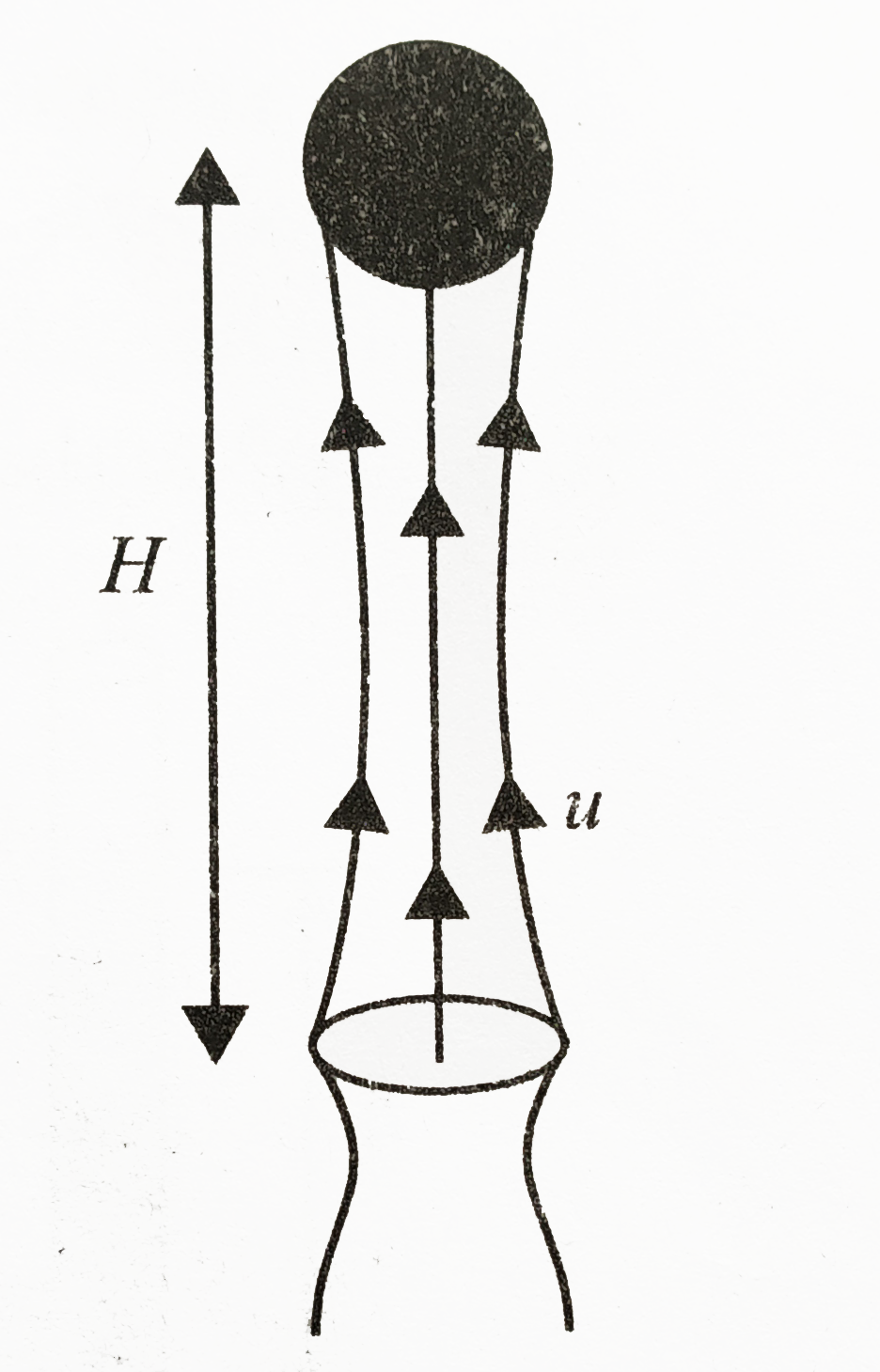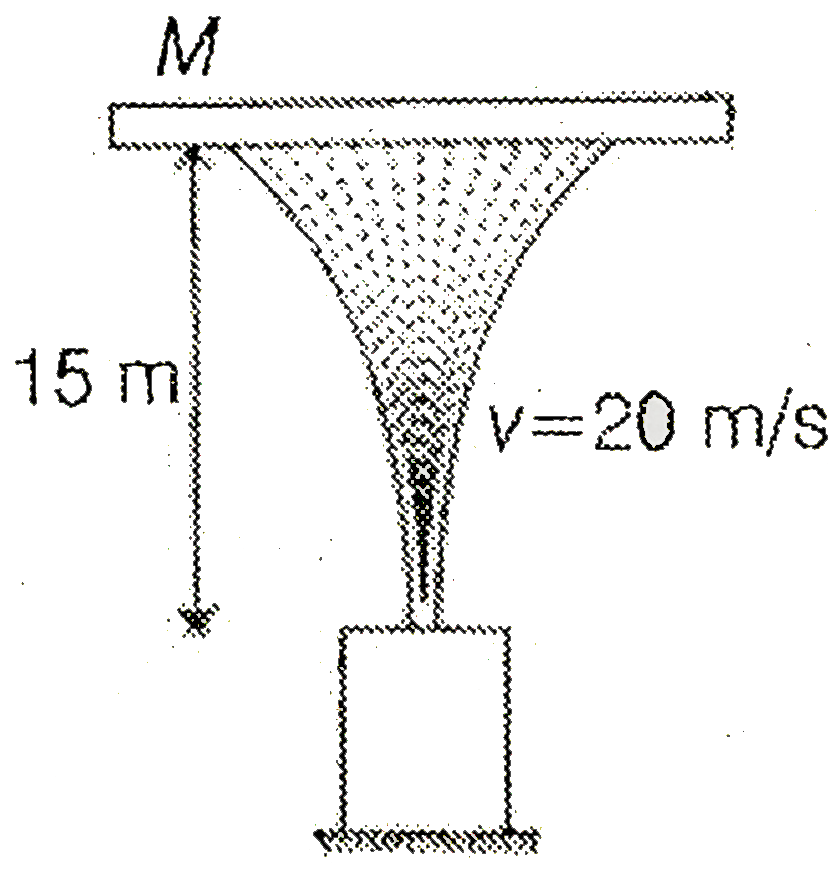A ping-pong ball of mass m is floating in air by a jet of water emerging out of a nozzle. If the water strikes the ping-gong ball with a speed v and just after collision water falls dead, the rate of flow of water in the nozzle is equal to
2mgV
mVg
mgV
none of these
The correct Answer is:C
To solve the problem, we need to determine the rate of flow of water in the nozzle that allows a ping-pong ball of mass m to float in air when struck by water moving with speed v. The water stops moving after hitting the ball, meaning its velocity becomes zero.
1. Understand the System:
- A ping-pong ball of mass m is floating in air due to the upward force provided by the water jet.
- The water strikes the ball with a speed v and comes to rest after the collision.
2. Identify the Momentum Change:
- The momentum of the water before the collision is given by Δp=Δm⋅v, where Δm is the mass of the water that strikes the ball in time Δt.
3. Force Acting on the Water:
- After the collision, the water comes to a stop, which means the change in momentum must equal the force acting on it over the time interval. The force acting on the water is due to gravity, which is F=mg.
4. Relate Momentum Change to Force:
- The change in momentum can also be expressed as F⋅Δt. Thus, we have:
Δm⋅v=mg⋅Δt
5. Rearranging the Equation:
- We can rearrange this equation to find the mass flow rate:
Δm=mg⋅Δtv
6. Rate of Flow of Water:
- The rate of flow of water, which is the mass of water flowing per unit time, is given by:
ΔmΔt=mgv
Final Expression:
- Therefore, the rate of flow of water in the nozzle is:
ΔmΔt=mgv
Conclusion:
- The correct answer for the rate of flow of water in the nozzle is mgv.
- A ping-pong ball of mass m is floating in air due to the upward force provided by the water jet.
- The water strikes the ball with a speed v and comes to rest after the collision.
- The momentum of the water before the collision is given by Δp=Δm⋅v, where Δm is the mass of the water that strikes the ball in time Δt.
- After the collision, the water comes to a stop, which means the change in momentum must equal the force acting on it over the time interval. The force acting on the water is due to gravity, which is F=mg.
- The change in momentum can also be expressed as F⋅Δt. Thus, we have:
Δm⋅v=mg⋅Δt
- We can rearrange this equation to find the mass flow rate:
Δm=mg⋅Δtv
- The rate of flow of water, which is the mass of water flowing per unit time, is given by:
ΔmΔt=mgv
- Therefore, the rate of flow of water in the nozzle is:
ΔmΔt=mgv
- The correct answer for the rate of flow of water in the nozzle is mgv.
Topper's Solved these Questions
- CENTRE OF MASSBOOK - CENGAGE PHYSICS ENGLISHCHAPTER - CENTRE OF MASSEXERCISE - Multiple Correct
25 Videos
- CENTRE OF MASSBOOK - CENGAGE PHYSICS ENGLISHCHAPTER - CENTRE OF MASSEXERCISE - Assertion - Reasoning
2 Videos
- CENTRE OF MASSBOOK - CENGAGE PHYSICS ENGLISHCHAPTER - CENTRE OF MASSEXERCISE - Subjective
23 Videos
- CALORIMETRYBOOK - CENGAGE PHYSICS ENGLISHCHAPTER - CALORIMETRYEXERCISE - Solved Example
13 Videos
- DIMENSIONS & MEASUREMENTBOOK - CENGAGE PHYSICS ENGLISHCHAPTER - DIMENSIONS & MEASUREMENTEXERCISE - Integer
2 Videos
Similar Questions
A tank of height H and base area A is half filled with water and there is a small orifice at the bottom and there is a heavy solid cylinder having base area A3 and height of the cylinder is same as that of the tak. The water is flowing out of the orifice. Here cylinder is put into the tank to increase the speed of water flowing out.
After long time, when the height of water inside the tank again becomes equal to H2, the solid cylinder is taken out. then the velocity of liquid flowing out of the orifice (just after removing the cylinder) will be
View SolutionA ball of weight W is supported on a vertical jet of water. If the stream of water flowing from the nozzle has a diameter D and velocity u, determine the value of H. Assume that no loss of energy takes place.

View SolutionA block of mass m and a pan of equal mass are connected by a string going over a smooth light pulley as shown in figure. Initially the system is at rest when a particle of mass m falls on the pan and sticks to it. If the particle strikes the pan with a speed v find the speed with which the system moves just after the collision.
View SolutionA jet of water hits a flat stationary plate perpendicular to its motion. The jet ejects 500g of water per second with a speed of 1m/s. Assuming that after striking, the water flows parallel to the plate, then the force exerted on the plate is a) 5 N b) 1.0 N c) 0.5 N d) 10 N
View SolutionIn an experiment to verify Stokes law , a small spherical ball of radius r and density ρ falls under gravity through a distance h in air before entering a tank of water. If the terminal velocity of the ball inside water is same as its velocity just before entering the water surface , then the value of h is proportional to : ( ignore viscosity of air ) .
View SolutionA ball of mass m moving with a velocity v along X-axis, strikes another ball of mass 2m kept at rest. The first ball comes to rest after collision and the other breaks into two equal pieces. One of the pieces starts moving along Y-axis with a speed v1. what will be the velocity of the other piece?
View SolutionA vertically jet of water coming out of a nozzle with velocity 20m/s supports a plate of mass M stationary at a height h=15m, as shown in the figure. If the rate of water flow is 1 litre per second, the mass of the plate is (Assume the collision to be perfectly inelastic).

View SolutionA water pipe has an internal diameter of 10 cm. Water flows through it at the rate of 20 m/sec. The water jet strikes normally on a wall and falls dead. Find the force on the wall.
View SolutionA jet is releasing water at the rate of 6 kg/see with speed of 4 m/sec. Now this water strikes a block of mass 10 kg. find the force exerted on block & its acceleration ?
View SolutionAn engine pumps water continously through a hose. Water leave the hose with a velocity v and m is the mass per unit length of the Water jet. What is the rate at Which kinetic energy is imparted to water?
View Solution
